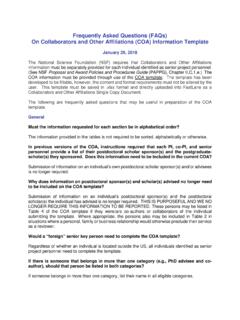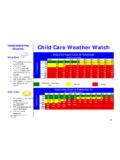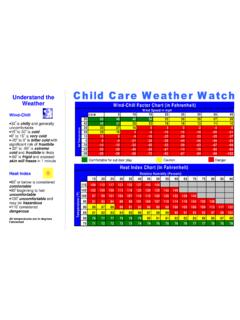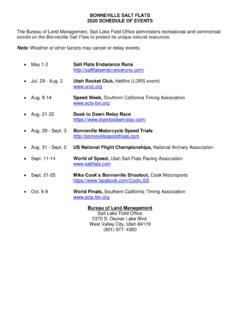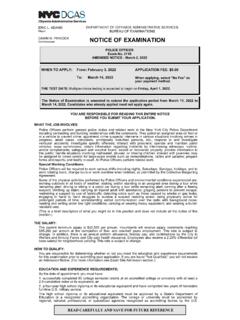Transcription of Weather and Climate Modification - NSF
1 NSF 66-3 Weather AN Climate Modification Repori 01 ine SPECIAL COMMISSION ON Weather MOIJIFICATION NATIONAL SCIENCE FOUNDATION WEAMER AND Climate Modification Repori 01 me SPECIAL COMMISSION ON Weather MODIRCATION NATIONAL SCIENCE FOUNDATION LETTER OF RANSMITTAL The Honorable Leland J. Haworth Director National Science Foundation Washington, D. C. Dear Dr. Haworth: It is an honor to transmit herewith to the National Science Foundation the report of the Special Commission on Weather Modification , authorized by the National Science Board at its meeting on October 17-18, 1963, in accordance with Sections 3(a)(7) and 9 of the National Science Foundation Act of 1950, as amended, and appointed by you on June 16, 1964. The Commission was requested to examine the physical, biological, legal, social, and political aspects of the field and make recommendations concern ing future policies and programs.
2 The physical science aspects have been studied primarily through cooperative liaison with the National Academy of Sciences' Panel on Weather and Climate Modification . Much of the background work for the treatment of the other aspects of the problem was carried out under National Science Foundation grants or contracts, reports of which research and study are to be published as stated in the Appendix. The Commission held eleven meetings supplemented by many days of study, research, writing and conferences. The Commission report has been prepared by and its content is concurred in by all the members of the Commission. The Commission was assisted throughout its deliberations by an Executive Secretary. Dr. Edward P. Todd served in this capacity during the early months. Mr. Jack C. Oppenheimer succeeded Dr. Todd and has done an outstanding job of assisting the Commission.
3 Respectfully submitted, A. R. Chamberlain, Chairman Vice President Colorado State University December 20, 1965 I" The Commission was established pursuant to Section 3(a)(7) and 9 of the National Science Foundation Act of 1950, as amended. The names and affiliations of the Commission members are: A. R. Chamberlain, Chairman Vice President, Colorado State University John Bardeen, Vice Chairman Departments of Physics and Electrical Engineering University of Illinois William C. Colman, Executive Director Advisory Commission on Intergovernmental Relations John C. Dreier School of Advanced International Studies The Johns Hopkins University Leonid Hurwicz Department of Economics University of Minnesota Thomas F. Malone, Second Vice President Research Department Travelers Insurance Company Arthur W. Murphy Columbia University School of Law Sumner T. Pike Lubec, Maine William S.
4 Von Arx Massachusetts Institute of Technology and Woods Hole Oceanographic Institution Gilbert F. White Department of Geography University of Chicago Karl M. Wilbur Department of Zoology Duke University SPECIAL COMMISSION ON Weather Modification iv ONTENT$ LETTER OF TRANSMITTAL .. iii SPECIAL COMMISSION ON Weather Modification iv HISTORICAL BACKGROUND ..1 Introduction .. 7 Scientific Possibilities ..11 Biological Implications .. 18 The Social Effects ..20 TheLaw .. 23 Needs and Opportunities for International Cooperation .. 26 Fiscal and Organizational Considerations ..29 PROGRESS AND PROSPECTS IN Weather AND Climate Modification ..34 Introduction .. 34 The Nature of the Scientific Problem .. 34 Present Status of Weather Modification .. 38 Accomplishments of the National Science Foundation Program .. 43 Activities in Foreign Countries.
5 47 Perspectives for Research .. 50 Conclusions and Recommendations .. 58 BIOLOGICAL ASPECTS OF Weather Modification .. 60 Introduction .. 60 Means of Predicting Consequences of Weather Modifi- cation ..60 Predicted Biological Responses of Weather Modifica- Conclusions and Recommendations of The Ecological Society Working Group ..69 STATISTICAL ASPECTS OF Weather Modification .. 71 The Present Situation ..71 The Conferences on Statistical Methodology ..71 Conference Findings .. 72 Conference Recommendations .. 73 V Precipitation-Oriented Experiments .. 74 The Empirical Approach .. 75 Numerical Modeling and Simulation .. 76 Commission Recommendations .. 77 Footnote .. 79 THE HUMAN EFFECTS OF Weather AND Climate MODI- FICATION .. 80 Weather Modification AND INTERNATIONAL RELA- International Programs Related to Weather Modifica- Four Interlocking Systems.
6 82 Uncertainty .. 84 Two Approaches to the Human Dimensions .. 85 Broader Considerations .. 85 Evaluating Social Effects .. 86 Conflicts of Interest .. 90 Desirable Courses of Action .. 92 Recommendations .. 97 98 LEGAL AND LEGISLATIVE ASPECTS ..100 113 115 International Requirements of Research .. 117 Weather Modification and World Politics ..118 Relation to U. S. Foreign Policy .. 119 International Impact on U. S. Program .. 120 Organization of Inter-Governmental Cooperation .. 121 Scientific and Technical Exchange .. 122 International Legal Problems .. 122 Questions of International Organization .. 123 Recommended Basic Policy Statement .. 124 FUNDING AND ADMINISTRATION REQUIREMENTS .. 126 Federal Financial Support of Weather and Climate Mod- ification .. 126 Administration .. 130 149 vi HISTORICAL BACKOHOUND Twenty years ago General Electric Company scientists Irving Langmuir and Vincent Schaefer modified clouds by "seeding" them with dry ice pel lets.
7 Not long afterward Bernard Von negut, a co-worker, demonstrated that a smoke of silver iodide crystals would accomplish the same result. This was the beginning of the modern American history of Weather and cli mate Modification through cloud seeding. These American scientists on No vember 13, 1946, had verified experi mentally the theory advanced in 1933 by the Swedish meteorologist, Tor Bergeron, and the German physicist, Walter Findeisen, that clouds would precipitate if they contained the right mixture of ice crystals and super cooled water drops. The Bergeron-Findeisen theory was antedated by the work of the Dutch scientist, Au gust Veraart. The enthusiastic reports by Veraart of his 1930 experiments with dry ice and supercooled water-ice in Holland were not well received by the Dutch scientific community, and thus were given no serious considera tion elsewhere.
8 Weather and Climate Modification , or "rainmaking" (the more popular and also more restricted concept), is not new to our era or to our country. Many traditional societies, including the American Indians, have practiced some type of religious or ritualistic rainmaking. The ceremonials and rit uals have varied from dousing holy men with water to burying children up to their necks in the ground in the hope that the gods would be sympa thetic and drop tears from the heav ens. These ceremonies are not only to induce some form of desirable Weather but also to reinforce the tribal reli gious beliefs and opinions which maintain social unity. Through ancient and modern times many methods have been proposed and attempted to induce or to aid rainfall. Two U. S. Government pat ents on methods of rainmaking were issued before the turn of the 20th century based, respectively, upon the production of carbon dioxide by ex pending "liquified carbonic acid gas" and upon concussion by the detona tion of explosives.
9 Interestingly enough the long since expired patent, based on the production of carbon dioxide in the form of dry ice, antici pated the cloud seeders of today. The pioneering field and laboratory work of meteorologists in the War and Navy Departments on the popular notion 1 that rainfall could be caused by the detonation of explosives was sup ported by Federal Government funds. Even social, political and legal con flicts over Weather and Climate modi fication are not new. In 1916 San Diego's employment of a rainmaker, resulting in claims of loss of life and property damage of a million dollars, anticipated by half a century the liti gation and State and local legislative action of today. The 1946 demonstration that clouds might be modified and rain produced by scientific methods arose out of the World War II investigations of fog particles by Langmuir and Schaefer.
10 The military possibilities of this dis covery led the armed services to sup port a broad theoretical, laboratory and field program in cloud modifica tion from 1947 to 1952, known as Project Cirrus. Civilian and military implications were investigated by the Cloud Physics Project of the U. S. Weather bureau , Air Force and Na tional Advisory Committee for Aero nautics from 1948 to 1951. The mili tary services followed the termination of Project Cirrus in 1952 with a De partment of Defense 5 year Artificial Cloud Nucleation Project. Whether or not the multi-million dollar commercial rainmaking activi ties of the late 1940's and early 1950's grew out of the obvious interest of the Federal Government in Weather and Climate Modification research or the coincidental severe drought conditions in some parts of the nation, relatively vast operations became a fact of life.
